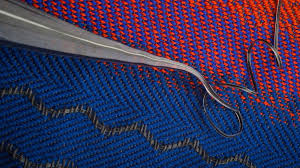Resonant Revolution: MIT’s Silk Sheets as Acoustic Engineers in Smart Textile Technology
Silent Silk: Revolutionary Acoustic Solutions from MIT’s Smart Textile Innovations
Hey there textile enthusiasts and tech aficionados! Today, we’re diving into some truly groundbreaking advancements in smart textiles that could change the way we live our noisy lives. Let’s unravel the phenomenon of MIT’s special silk sheets, which don’t just sit pretty on your bed—they actively suppress sound by giving off good vibrations. As an ardent lover of all things fiber and fabric, I couldn’t be more excited to shed some light on this captivating innovation.
The Birth of Textile Sound Engineers
Imagine this: thin, delicate sheets of silk not only adding a touch of luxury to your home but also acting as high-tech sound moderators. The story starts with brilliant scientists at MIT who, driven by their previous success in converting fabric into microphones, embarked on a new mission: transforming these fabrics into speakers. Silk, nature’s own wonder material, turned out to be a perfect candidate due to its inherent vibrational qualities. We all know silk for its smooth, luxurious feel, but who knew it could double up as a smart textile that sings and silences?

Piezoelectric Magic: Silk + Sound
Let’s get into the nitty-gritty of how these magical silk sheets work. The core technology here hinges on something called a piezoelectric fiber**, a special material that deforms when an electrical current passes through it. When this current fluctuates rapidly, the fiber dances between its natural and deformed states, producing vibrations that propagate through the sheet.
Now picture this fiber elegantly adhered down the center of a silk sheet just 0.13 mm thick. These vibrations displace the air, creating sound waves similar to how speakers function. The silk sheet then becomes a small-scale sound generator, capable of emitting up to 70 decibels of sound and reducing noise by up to 37 dB.
But how does this work, and why silk? Silk boasts exceptional properties—its fine weave and inherent strength make it a superior substrate for these piezoelectric fibers. It isn’t just a supremely tactile fabric; it’s a controllable, vibrational marvel.
The Duality: Blocking and Returning Sound
The ingenuity of this material doesn’t end with generating sound. There are two primary ways these silk sheets combat noise:
1. Active Noise Cancellation Through Interference**: When the fabric’s created sound waves are deliberately out of phase with the unwanted noise waves, they cancel each other out. This principle, akin to the workings of noise-cancelling headphones, is effective in smaller spaces and close-range scenarios.
2. Vibration Prevention for Sound Blocking**: Instead of having the fiber vibrate to produce sound, it can be employed to hold the fabric rigid, preventing it from resonating with the incoming noise waves. When mounted on a wall, for instance, this method significantly diminishes vibrations that would otherwise transmit unwanted sounds through the wall. In lab tests, this tactic was reported to reduce these vibrations by up to 95%—resulting in a 75% reduction in transmitted noise.
Now, how about reflecting sound? The scientists discovered another fascinating feature: these sheets could reflect noise back towards its source, enhancing their ability to turn unwanted sounds to their senders’ dismay. Tests showed up to a 68% increase in noise reflection thanks to the robust, sound-fighting power of silk.
An Interdisciplinary Triumph
This groundbreaking research is not just the work of one institution—MIT collaborated with researchers from Case Western Reserve University, the University of Wisconsin at Madison, and the Rhode Island School of Design. This multi-faceted approach combined engineering prowess with textile design innovation, delivering a product as aesthetically pleasing as it’s functionally revolutionary.
Broader Implications: From Bedrooms to Urban Slumber
It’s in the bedrooms and living rooms of the world where noisy interruptions most affect us. Imagine using a soft, elegant silk curtain to shield your home from street noise or an adjoining apartment’s uproar. These adaptable sheets give us a glimpse into smarter home environments, where our fabrics are more than a visual delight—they are guardians of our peace and quiet.
Now, take one step further. Think of external use: installed outside homes, these sheets could reduce urban noise pollution significantly. Parks, public spaces, even potentially in vehicular settings where noise reduction is paramount.
The Future of Smart Textiles
As someone deeply passionate about textiles and their technological potential, it’s thrilling to witness such advancements that blend age-old materials with cutting-edge science. The development of these silk sheets exemplifies the promise of smart textiles**—an industry stepping beyond traditional confines to reimagine what our fabrics can do.
The beauty of this innovation lies not only in its immediate applications but in its potential for growth. As we refine and scale such technologies, we may soon see silk and other fabrics embedded with smart capabilities that extend beyond sound suppression. Potential applications include healthcare (imagine bed sheets that monitor your vitals), fashion (clothing that adjusts its properties based on environmental conditions), or even safety (fabrics that communicate threats or hazards).
Understanding Keywords in Smart Textiles
Before wrapping up, let’s deepen our understanding with some key concepts central to this innovation:
Piezoelectric Materials**: These are substances that generate an electric charge in response to mechanical stress. They bridge the gap between electrical and mechanical domains, making them pivotal in sensors, actuators, and now, smart textiles.
Vibration Dampening**: This principle involves reducing the amplitude of vibrations. In sound engineering, vibration dampening in materials like these silk sheets prevents the transmission of undesired noise.
Phase Interference**: A phenomenon wherein two waves superpose to form a resultant wave of greater, lower, or the same amplitude, depending on their phase relationship. Active noise cancellation leverages this by creating destructive interference with unwanted noise.
A Nod to the Silk-Weaving Legacy
One fascinating thought is the potential resurgence of the silk-weaving industry, particularly in East Asia, where millennia-old traditions have perfected the silk craft. This technology could invigorate these industries with high-tech applications, creating new markets and revitalizing economies steeped in textile heritage.
In Conclusion
The era of smart textiles is not just upon us—it’s flourishing with innovations like MIT’s sound-suppressing silk sheets. This blend of ancient material and modern science heralds a new age where our environments are smarter, quieter, and more attuned to our need for tranquility.
As the world gets noisier, these silk sheets represent a silent revolution. Kudos to the textile engineers, researchers, and innovators crafting tomorrow’s fabrics. It’s a wonderful time to be a textile enthusiast, and I can’t wait to see where these good vibrations take us next. Keep weaving your passion with tech, and stay tuned for more tales from the textile frontier. Until next time, fiber fanatics!
Warm regards,
Textile Topher**
Keywords: Smart textiles**, Piezoelectric fiber**, **Noise cancellation**,
(Post number: 5), **MIT innovations**, **Sound suppression**





